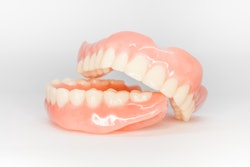
Like life, tooth loss happens. Whether due to periodontal disease, decay, fracture, injuries, cancer, or just plain wearing out, dental professionals are bound to replace missing teeth -- that's what we do.
According to the American College of Prosthodontists, tooth loss is incredibly common. More than 36 million Americans do not have teeth, and 120 million people in the U.S. are missing at least one tooth. These numbers are growing, and tooth loss is especially common among the aging and economically disadvantaged. The consequences of missing teeth include significant nutritional changes, obesity, diabetes, coronary artery disease, and some forms of cancer.
 Belle DuCharme.
Belle DuCharme.Equally important, dentures are incredibly common for edentulous people. The American College of Prosthodontists reports that 90% of those with edentulism have dentures, and about 15% of the edentulous population has dentures made each year.
These statistics reinforce why it's so important for dental professionals to know how to code for and get paid for dentures. However, doing so can be challenging.
More codes are added yearly, and some are deleted or revised. If the claim is not coded correctly based on the actual treatment, a denial by the insurance provider is certain.
Because coding treatment becomes more complicated each year, a provider must make detailed clinical notes that the practice insurance coordinator can decipher and create a clean claim for rapid reimbursement.
Know your codes
Over the years, the ADA Current Dental Terminology (CDT) coding for dentures has included full, partial, removable, and fixed dentures. Implant/abutment-supported dentures (overdentures) have changed and broadened the scope of replacing teeth. Below I outline what you need to know about each type.
Refer to the latest CDT publication for further important information regarding all codes noted in this article. Each year some of the CDT codes are deleted, revised, or new codes are added. Revisions of coding language may change how a code is used from how it was used in the past.
1. Removable prosthodontics
CDT codes D5000-D5899 are for removable prosthodontics. The following are two standard codes for complete, removable dentures: D5110 and D5120.
The coding descriptions for the upper arch, maxillary, and the lower arch, mandibular are the same as the limitations for benefits under plan policies. Remember to include clinical notes of the age and condition of the existing prosthetics and the medical necessity for the reason for replacement.
Coding consideration
D5110 and D5120 should not be used to record an immediate denture (one that is placed immediately after extractions). Instead, use D5130 for an immediate complete maxillary denture and D5140 for an immediate complete mandibular denture.
2. Interim complete dentures
An interim (provisional) complete maxillary or mandibular denture is used when the patient will need a future final definitive complete denture. The final denture could be complete, a natural tooth overdenture, or an implant/abutment-supported removable denture. The final decision is between the providers' recommended treatment and the patient's needs and wants.
The following are codes for interim complete dentures:
- D5810 is used to record an interim maxillary complete denture inserted immediately after extractions.
- D5811 records an interim mandibular complete denture inserted immediately after extractions.
Insurance considerations
Most insurance companies consider D0470 -- Diagnostic Casts as part of the global fee for both complete and partial dentures. If casts are billed to an insurance plan separately, it may be paid per limitations, like once in a lifetime, or not covered independently from the prosthetics billing.
There is a typical exclusion period of five to 10 years for replacing an existing denture, a complete and partial, or inserting an original denture. An estimated time is fine if you cannot get definitive records or if insurance coverage is not in effect. Often, the patient needs to remember the date they were placed, where, or if the same insurance covered them. It is better to find this information out instead of receiving a surprising claim denial from the insurer.
The replacement time varies from plan to plan. You can appeal the replacement limitation by thoroughly documenting with clinical notes, photos, and radiographs the medical necessity of replacement and why the existing denture is no longer serviceable or repairable for the patient.
Adjustments after the placement of new dentures usually are not covered for the first six months. The adjustment might be paid if the patient has to go to a dental practice that did not create or place the denture.
Common reimbursement challenges
Preferred provider organizations (PPOs) and other types of contracts have language that affects the final payment of services for dentures. For example, interim complete dentures D5810 (maxillary) and D5811 (mandibular) may not be a covered expense because they are not the final product. If the insurance plan pays for the interim dentures, they most likely will subtract that payment from the final permanent complete denture benefit.
In some cases, if the interim denture(s) is worn for more than a year, it is considered a permanent restoration. It is essential to read each policy's exclusions and limitations and inform the patient with a written treatment plan and obtain informed consent.
3. Partial dentures
There are a number of important partial denture codes (D5211-D5214 and D5221-D5224) in the CDT Code book. Please note this article will not cover other types of partials, such as flexible base and one-piece unilateral partials and bilateral partials. Also, note that the latter codes are used for immediate partial dentures placed on the same day as extractions.
Insurance considerations
Report D5820 for a short-term partial that is intended to be in place only until the final restoration is seated. This partial is often referred to as a "temp" or a "flipper" and is not considered an interim or complete restoration. Many PPO contracts require that all services performed for the patient be billed regardless of whether they are a listed covered benefit or not.
Documentation of the chart to report precisely the prosthetic, whether maxillary, mandibular, complete, immediate, or interim, will determine whether the insurance claim will be filed correctly and there will be fewer denials and appeals.
When extracting teeth, it is essential to correctly record the teeth numbers. Some teeth have migrated to another position, which could cause the extraction to be denied because it is the wrong tooth number.
Record the dates of the extractions with the corresponding teeth numbers.
Common reimbursement challenges
Follow-up adjustments under most PPO contracts are only a covered benefit after six months (healing period) of placement. Contact the plan payer regarding relines or rebases before the six months are up.
Immediate cast metal framework partial dentures may be reported on the impression date, but some payers may pay after the teeth are extracted and the immediate is delivered. If the claim is denied because the denture has not been delivered, you will have to resubmit the claim after the partial and include the teeth that were extracted and the reasons for the extractions.
Do not bill flexible base partials made of Valplast or Proplast as resin dentures. There are separate codes for flexible-based partials.
Some plans may have age restrictions for partial dentures. Check with the plan administrator.
All teeth that are missing or that have been extracted must be identified on the claim, and supportive radiographs or photos must be viable. If the partial is a replacement of an existing partial denture, the date of initial placement must be included in the clinical notes/narrative.
Soft healing liners within the first six months of delivery are considered part of the global fee for partial dentures.
4. Overdentures
Overdentures (D5863-D5866) are supported by natural teeth (not implants) still rooted in the jawbone. Sometimes these teeth have been treated prior with endodontics and have attachments (D5862) to support the denture. Root canal therapy and attachments (one attachment per line) are coded separately on the claim.
5. Implant-supported prosthetics
There are two groups of implant-supported prosthetics supported by implants/abutments (D6110-D6113) and implant-supported prosthetics supported by fixed dentures (D6114-D6117).
Note that codes D6053 and D6054 are deleted codes. D6110 and D6111 are replacement codes for implant/abutment-supported removable dentures for an edentulous arch.
Likewise, D6078 and D6079 are deleted codes. D6116-D6117 are the new codes for these types of dentures. Also, D6118-D6119 are codes for implant-supported interim fixed dentures. They are not discussed in this article.
Insurance considerations
Verify plan benefits for implants on the policy if the patient is expecting to receive insurance payments. Many dental plans do not cover implant placement or any treatment related to implants. Other programs may offer implant coverage but have a least expensive alternative treatment (LEAT) clause that allows the plan administrator to "downcode" to a LEAT, such as a standard partial denture.
It is suggested to present the costs without guaranteeing insurance benefits for treatment planning. Some plans have an implant rider separate from the primary policy and coverage, but it must meet the plan policy language.
A solid supportive narrative is necessary to explain why an implant-supported denture is better for this patient versus an alternative product.
Common reimbursement challenges
Dentures usually have a standard replacement limitation of five to 10 years. Verify the limitation time with the plan administrator.
Implant coverage on dental plans is subject to LEAT clauses. Most dental plans' maximum per calendar year is about $1,000 to $2,000. Implants are typically much more than the calendar year maximum. Often patients will use their benefits for cleanings, exams, x-rays, and other services, leaving a few dollars behind for treatment on an implant.
Lost dentures are typically not covered by insurance plans.
Belle DuCharme has been a dedicated writer, speaker, and consultant for the dental profession for decades. With a solid foundation in practice management and clinical experience, DuCharme has helped hundreds of dental clients achieve practice growth and stability. Her mission is to help other dental professionals create standards for financial and clinical success. You can reach her at [email protected].
The comments and observations expressed herein do not necessarily reflect the opinions of DrBicuspid.com, nor should they be construed as an endorsement or admonishment of any particular idea, vendor, or organization.



















